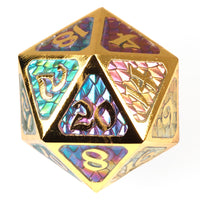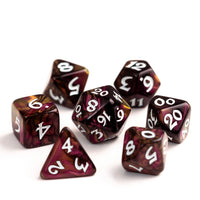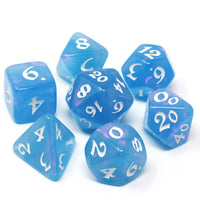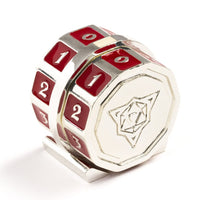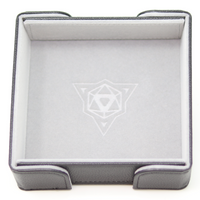The Archimedean d4

What, and why?
A New d4 Shape
The traditional d4, often referred to as the 'pyramid' or 'caltrop' die, has long been a source of frustration for tabletop gamers.
A traditional d4 is prone to rolling unpredictably, erratically, or more commonly, not at all. This problem is even more noticeable when using a metal d4. The increased weight means that most of the time they simply slide across your rolling surface.
All of these issues come from the shape of the traditional d4, called a tetrahedron. Generally speaking, the more faces a die has, the more smoothly it will roll. Because tetrahedrons only have four faces, they do not tumble well at all.
Because tetrahedrons do not have a top-facing surface, they have to be read differently than the other six dice in a 7-piece set, which can cause confusion among new gamers.
For these reasons, we went looking for a new shape we could use in place of a tetrahedron. What we didn't expect was that we'd also find a fun new crit dynamic along the way.

Existing Options
d4 Alternatives
Although there are already many alternatives to the traditional d4, we did not feel that any existing solutions solved all of the problems. There are alternatives that are top-read, roll well, or looked aesthetically pleasing in a 7-piece set, but we couldn't find something that checked all three boxes at once.
The breakthrough for us came when we allowed ourselves to think unconventionally about the traditional tetrahedron d4. We don't hate the shape, but have always felt it was a little out-of-place.
We liked the blunted tetrahedron that we use in many of our existing designs, but loved the idea of a top-read d4. The problem was that we also disliked the traditional d4's number layout system. Even when other solutions created a tetrahedron-based solution that had a top-read number, they also inevitably relied on the secondary method of having three results on each side.
But what if those small faces weren't only for displaying numbers? What if they were large enough for the die to actually land on them? This question is what eventually led to creation of the Archimedean d4.
A Tour of Truncated Tetrahedrons

Tetrahedron
This traditional d4 shape has four equilateral triangles as faces. Though not discovered by Plato, tetrahedrons are featured prominently in his philosophy, and are therefore considered a Platonic solid.

Truncated Tetrahedron
A truncated tetrahedron is a shape described by Archimedes where the tips of a tetrahedron are truncated until four faces are equilateral triangles and four faces are equilateral hexagons.

Blunted Tetrahedron
Created by truncating the tips of a tetrahedron by a smaller amount than Archimedes' truncated tetrahedron, this shape promotes better rolling than a traditional d4.

Archimedean d4
Although our new d4 shape does not have equilateral hexagons, it bears a striking similarity to the truncated tetrahedron described by Archimedes, which is why we call it an Archimedean d4.

Big Ups!
A d4 That Crits, You Say?
The initial goal might have just been to create a fair d4 with top-read numbers that rolled well and aesthetically matched a 7 piece set, but what we didn't expect was to find a fun new crit mechanic with d4 dice along the way.
After making the new d4, we found that not only could it land with a large face up, but after extensive testing, it had a 5% chance of having a large face up. This is the same probability of rolling a natural 20 on a d20.
This probability was observed twice after 5,000 rolls using a dice tower. While this may not be enough testing to make its way to a casino table, it's definitely enough to safely use as a fun mechanic at your own table.
There may not be game mechanics built around the Archimedean d4 yet, but imaginative Game Masters can easily include an extra crit mechanic for characters using fists, daggers, or health potions!
What's next for the Archimedean d4?
Well, we're not sure yet. It really depends on what you think of it.
Our very first public poll back in 2015 was about the traditional shape of the d4, and just how far the public would accept changes to it. The results of that poll taught us that there is some resistance to change. Or, at least there was enough resistance back in 2015 that we've waited this long to make any drastic alterations.
We have seen a lot change in our community in the last seven years, and we hope that there is room for a unique new approach to the d4. We also hope that homebrew dice makers will find it interesting enough to test.
If the initial sets that use the new Archimedean d4 are successful, it's a guarantee that you'll see more of them going forward.
For now, we're just ecstatic to finally have it in the hands of gamers and can't wait to hear what you think of it!
